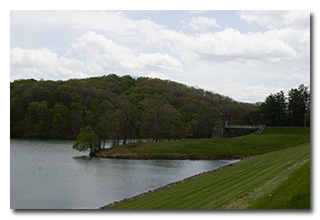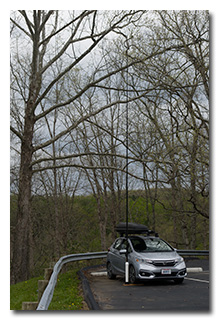
by William Eric McFadden
From the Wayne National Forest website:
-
The Wayne National Forest is a patchwork of public land that covers over a quarter million acres of Appalachian foothills of southeastern Ohio. The Forest is divided into three units managed out of two Ranger District offices located in Nelsonville and Ironton, with a field office in Marietta.
The Forest features over 300 miles of trails for hiking, all-terrain vehicle riding, mountain biking, or horseback riding in season. The trails are open to ATVs, mountain bikes, and horseback riders from mid-April to mid-December each year. Come visit the Wayne and hike or ride our trails!
From the North Country National Scenic Trail website:
-
Come to the North Country. Trek the hills and valleys. Stand on the shores of lakes & streams from glaciers 10,000 years before. Clear-flowing water, red/gold of autumn, a fairyland of snow, open prairies, and distant horizons paint the land. Historic sites along the way tell how America settled and grew as a nation. From North Dakota to New York (and soon Vermont), adventure is never far away.
Pictures
- Burr Oak Lake
- Two views of Eric's station: 1 | 2
Description
 On Friday, April 30, 2021, one member of the Southeast Ohio Radio Adventure Team
performed a successful two-fer activation of Wayne National Forest (K-4521) and North Country National Scenic Trail
in Ohio (K-4239) as part of the Parks on the Air (POTA; link) program.
Eric McFadden, WD8RIF, performed the two-fer activation at Tom Jenkins Dam on a cool and very blustery afternoon.
This would be Eric's eighteenth POTA activation of Wayne National Forest and his seventeenth POTA activation of
North Country National Scenic Trail.
On Friday, April 30, 2021, one member of the Southeast Ohio Radio Adventure Team
performed a successful two-fer activation of Wayne National Forest (K-4521) and North Country National Scenic Trail
in Ohio (K-4239) as part of the Parks on the Air (POTA; link) program.
Eric McFadden, WD8RIF, performed the two-fer activation at Tom Jenkins Dam on a cool and very blustery afternoon.
This would be Eric's eighteenth POTA activation of Wayne National Forest and his seventeenth POTA activation of
North Country National Scenic Trail.
Eric arrived at Tom Jenkins dam at about 1645 UTC and, finding the parking lot nearly empty, quickly deployed his 28½' wire vertical on the Jackite 31' telescoping fiberglass mast and drive-on mount. Because of the very gusty wind, Eric chose to set up his KX3 inside the car. Eric was on the air at 1707 UTC.
 As at previous visits to this location, Eric found he had good cell-signal and he was able to spot himself on the POTA Spots website
and to use POTA Spots to identify possible Park-to-Park (P2P) QSOs.
As at previous visits to this location, Eric found he had good cell-signal and he was able to spot himself on the POTA Spots website
and to use POTA Spots to identify possible Park-to-Park (P2P) QSOs.
Eric began operations by looking at POTA Spots to identify possible P2P QSOs but band conditions prevented Eric from making any P2P QSOs at this time.
Finding what sounded like a clear frequency on 40m, Eric spotted himself to POTA Spots and began calling "CQ POTA". QSOs were very slow in coming and Eric also began to realize that there was another, very weak, QSO on the frequency. Eric succeeded in making four QSOs before deciding to move to a different 40m frequency and try his luck there. QSOs came more quickly on the new 40m frequency and Eric managed thirteen QSOs in a bit less than half an hour. This run included a P2P QSO with K4EES who was activating Cheaha Resort State Park (K-1037) in Alabama and a P2P QSO with KB3WAV who was performing a "4-fer" activation of Fort McHenry National Monument (K-0928), Captain John Smith Chesapeake National Historic Trail (K-4567), Star-Spangled Banner National Historic Trail (K-4581), and Washington-Rochambeau Revolutionary Route National Historic Trail (K-4582) in Maryland.
After the run on 40m, Eric again looked at POTA Spots for possible P2P QSOs and made a 30m P2P QSO with N0EVH who was activating Lone Jack Lake State Conservation Area (K-6471) in Missouri, a 20m P2P QSO with K5LE who was activating Spavinaw Wildlife Management Area (K-6376) in Oklahoma, and a 40m P2P QSO with KF9VV who was activating Bellevue State Park (K-2280) in Iowa.
In all, Eric made sixteen QSOs, including eight P2P QSOs counting KB3WAV's 4-fer. All of Eric's QSOs were CW and were made at the 5-watt level.
During his activation, the Ohio University Airport reported wind gusts of 37mph. The strong wind caused the Jackite mast's second-from-the-bottom section to collapse but the simple homemade drive-on mast mount proved itself to be capable of supporting the 31' mast even in the gusty wind.
Eric also submitted his log to the World Wide Flora and Fauna in Amateur Radio (WWFF; link) program for an operation at Wayne National Forest, KFF-4527.
(return)